
Clayton Lake State Park
modified from McLemore, V.T., 1997, Clayton Lake State Park: New Mexico Geology, v. 19, p. 22-25 and Hunt, A.P., 2010, Clayton Lake State Park, in The geology of northern New Mexico's parks, monuments, and public lands: Price, L. Greer, ed., p. 319-324.
Introduction

Clayton Lake State Park is approximately 12 mi northwest of Clayton on NM–370 in northeastern New Mexico (Fig. 1). Unlike most lakes in New Mexico, Clayton Lake was established in 1955 specifically as a recreational site by the State Game and Fish Commission after construction of the dam. In 1967 the site became Clayton Lake State Park. The lake offers excellent fishing and is stocked with rainbow trout, walleye pike, crappie, bluegills, bullheads, large-mouth bass, and channel catfish by the State Game and Fish Department. Boating is prohibited after the fishing season ends, so from October through April the park is a refuge for waterfowl.
Clayton Lake State Park lies on the northern edge of the Kiowa section of the Panhandle National Grasslands. This area has been administered by the U.S. Forest Service since the 1930s to assist in the rehabilitation of grassland agriculture in the area and provide outdoor recreation, watershed protection, and game and bird habitats. Mule deer, pronghorns, coyotes, badgers, and foxes along with ducks, geese, and many other bird species including hawks and eagles are found in the grasslands; Barbary sheep from Africa were introduced into the region in 1950. Many of these animals can be observed while enroute to Clayton Lake.
The Clayton Lake earthen dam impounds water from Seneca Creek (also known as Cieneguilla Creek, Fig. 2), a tributary of the Cimarron and Canadian Rivers. The dam is 92 ft high, 150 ft wide at the crest, and 150 ft long at the spillway (Foster, 1983; Young, 1984). It contains 400,000 cubic yards of dirt and is covered with basalt riprap. The lake covers 170 acres at capacity, impounding over a billion gallons of water.
Geology
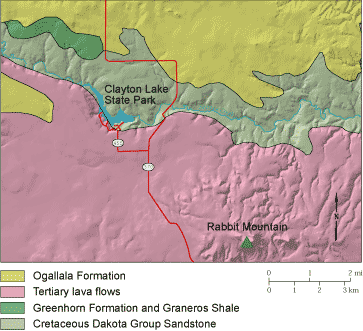
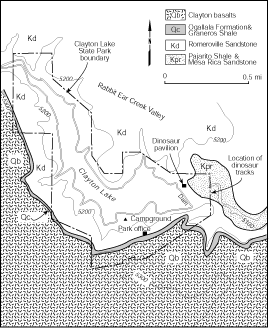
Clayton Lake State Park offers a diverse geologic setting. It lies in the Raton section of the Great Plains physiographic province, which is characterized by rolling hills, flat plains, and mesas that were intruded by numerous volcanoes forming lone mountain peaks and cones of various heights above the plains. The southern end of the Raton section is formed by the Canadian escarpment, north of the Canadian River. Basalt flows from the volcanoes protected the underlying sedimentary rocks from erosion and formed the tops of the mesas and flat plains.
The uppermost mesa above Clayton Lake is formed by Quaternary basalt flows that probably erupted from Rabbit Ear Mountain. Rabbit Ear Mountain is actually two summits that were once part of a single volcano, now largely eroded, similar in lithology and emplacement to the younger Capulin Mountain now protected as the Capulin National Monument east of Clayton. The basalts were erupted as continuous flows 9 to 100 ft thick composed of olivine (green spheres), plagioclase (white to clear laths), and augite (black laths) phenocrysts (mineral crystals) in a microscopic groundmass of augite, plagioclase, olivine, and magnetite. Many vesicles or small cavities or voids in the basalt formed by gas bubbles as the lava cooled. Some vesicles are filled with calcite crystals. These basalts are part of the Raton–Clayton volcanic field and are about 1.4-2.6 million years old (Nereson et al., 2013). As the visitor descends into the park, the contact between the basalt flow and underlying sediments can be observed along the road.
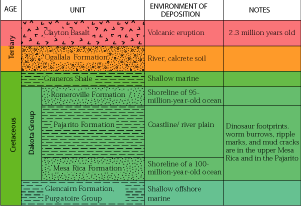
The basalt flows overlie the red to brown caliche sands of the Ogallala Formation of mid-Miocene to early Pliocene (4–12 million yrs ago) age (Frye et al., 1978). The Ogallala Formation is one of the most widespread units in the United States, extending from South Dakota to southern New Mexico and northwestern Texas, forming the Llano Estacado. The Ogallala Formation, the primary reservoir of ground water throughout the region, is responsible for man changing the appearance and character of the Great Plains. The Ogallala is 0–15 ft thick at Clayton Lake and consists of eolian sand and silt and fluvial sandy clay, siltstone, sandstone, and local gravel derived from the Rocky Mountains about 5–13 million years ago (Reeves, 1972; Hawley, 1984; Cather et al., 2012). Caliche beds are common throughout the unit. Caliche is composed of fractured and permeable deposits of gravel, sand, silt, and clay that is cemented by calcium carbonate (McGrath and Hawley, 1985).
The Ogallala Formation unconformably overlies the Cretaceous Graneros Shale, which forms covered slopes in the park. The Graneros Shale is predominantly gray shale found in local arroyo cuts and was deposited by the Cretaceous marine sea about 97.5–91 million yrs ago. Local invertebrate microfossils shaped like grains of rice, called Foraminifera, are found in the shale beds and confirm the Late Cretaceous (Cenomanian) age (Lucas et al., 1986; Hunt, 2010).
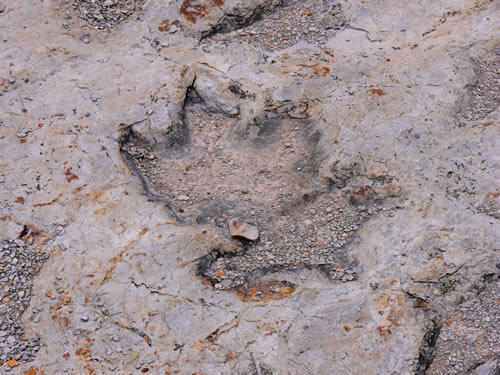
The Graneros Shale unconformably overlies the Cretaceous Dakota Group. The Romeroville Sandstone, the upper unit of the Dakota Group, consists of a thick quartzose sandstone unit that forms the lowest benches along the lake. It is yellowish orange to brown, fine to coarse grained, poor to well sorted, and bioturbated. Crossbeds and ripple marks are common locally, indicating fluvial deposition. Most of the beds surrounding the lake and above the spillway belong to the Romeroville Sandstone.
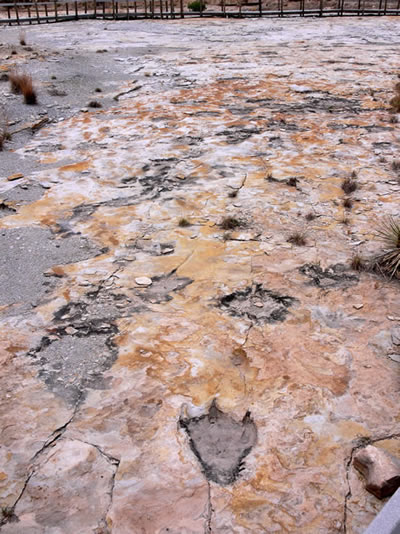
The Romeroville Sandstone overlies the Pajarito Shale. The Pajarito Shale, the middle unit of the Dakota Group, is approximately 12 ft thick and consists of interbedded gray silty shale, shaly siltstone, and quartzose sandstone (Lucas et al., 1986). The upper two horizons of dinosaur footprints are in the Pajarito Shale.
The Pajarito Shale overlies the Mesa Rica Sandstone, the basal unit of the Dakota Group. The Mesa Rica Sandstone is approximately 40 ft thick and consists of grayish-orange, medium- to coarse-grained, poorly sorted, quartzose sandstone (Lucas et al., 1986). Local beds contain crossbeds and ripple marks, indicating fluvial deposition. This unit also contains the stratigraphically lowest horizon (oldest) of dinosaur footprints. It overlies a micaceous shale belonging to the Cretaceous Glencairn Shale.
The most exciting geological feature at Clayton Lake State Park is the dinosaur footprints found in sandstone at the dam spillway about 1982. Approximately 500 tracks of at least three species are found at the spillway; most of them pertain to ornithopod dinosaurs (ichnogenus Caririchnium) and theropods (Hunt and Lucas, 1996; Hunt, 2010). The dinosaurs ranged in size from a baby Iguanodont that was approximately 1 ft long to adults that were 30 ft long. Most of the tracks are of bipedal herbivores or planteaters (Iguanodonts or Hadrosaurs). The kite-shaped tracks were made by Iguanodonts walking in wet mud (Figures 4,5, and 6). Worm borrows, fossilized impressions of plants, ripple marks from waves, and mudcracks are also common.
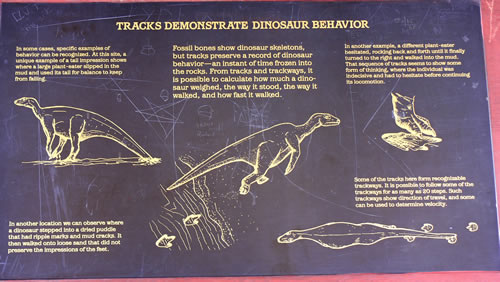
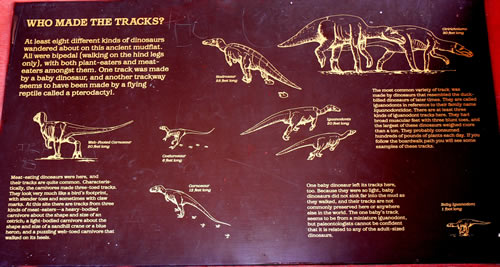
These tracks present excellent examples of the behavior of the dinosaurs. One set of prints was made by a swimming crocodile (Hunt and Lucas, 1996). Individual dinosaur tracks are along a single line, indicating that the dinosaur walked with his legs beneath him and not out to the side like modern reptiles. At one spot, the tracks suggest that a large planteater slipped in the mud and used his tail to keep his balance.
Earlier studies suggested that the host rocks belonged to the Romeroville Sandstone, but more detailed studies by Lucas et al. (1986) and Hunt and Lucas (1996) showed that the host rocks belong to the Pajarito Shale and underlying Mesa Rica Sandstone, both of which are older than the Romeroville. These stratigraphic studies suggest that the footprints are about 91–100 million yrs old.
References
- Baldwin, B., and Muehlberger, W. R., 1959, Geologic studies of Union County, New Mexico: New Mexico Bureau of Mines and Mineral Resources, Bulletin 63, 171 p.
- Cather, S.M., Chapin, C.E., and Kelley, S.A., 2012, Diachronous episodes of Cenozoic erosion in southwestern North America and their relationship to surface uplift, paleoclimate, paleodrainage, and paleoaltimetry: Geosphere, v. 8, no. 6, p. 1177–1206.
- Folsom, F., 1974, An amateur’s bonanza: discovery of early man in North America: The American West, v. 11, no. 6, p. 34–39.
- Foster, R., 1983, Clayton Lake: New Mexico Geology, v. 5, p. 81–82.
- Frye, J. C., Leonard, A. B., and Glass, H. D., 1978, Late Cenozoic sediments, molluscan faunas, and clay minerals in northeastern New Mexico: New Mexico Bureau of Mines and Mineral Resources, Circular 160, 32 p.
- Hawley, J. W., 1984, The Ogallala Formation in eastern New Mexico: Texas Tech University, Water Resources Center, Proceedings of the Ogallala Aquifer Symposium II, p. 157–176.
- Hunt, A.P., 2010, Clayton Lake State Park, in The geology of northern New Mexico's parks, monuments, and public lands: Price, L. Greer, ed., p. 319-324.
- Hunt, A. P., and Lucas, S. G., 1996, A reevaluation of the vertebrate Ichnofauna of the Mesa Rica Sandstone and Pajarito Formations (Lower Cretaceous: Late Albian), Clayton Lake State Park, New Mexico (abs.): New Mexico Geology, v. 18, no. 2, p. 57.
- Julyan, R., 1996, The place names of New Mexico: University of New Mexico Press, Albuquerque, 385 p.
- Lucas, S. G., 1990, Type and reference sections of the Romeroville Sandstone (Dakota Group), Cretaceous of northeastern New Mexico; in Bauer, P. W., Lucas, S. G., Mawer, C. K., and McIntosh, W. C. (eds.), Tectonic development of the southern Sangre de Cristo Mountains, New Mexico: New Mexico Geological Society, Guidebook 41, p. 323–326.
- Lucas, S. G., Hunt, A. P., Kietzke, K. K., and Wolberg, D. L., 1986, Cretaceous stratigraphy and biostratigraphy, Clayton Lake State Park, Union County, New Mexico: New Mexico Geology, v. 8, p. 60–65.
- McGrath, D. A., and Hawley, J. W., 1985, Calcretes of the Santa Rosa area; in Lucas, S. G., and Zidek, J. (eds.), Santa Rosa–Tucumcari Region : New Mexico Geological Society, Guidebook 36, p. 4–6.
- Nereson, A., Stroud, J., Karlstrom, K., Heizler, M., and McIntosh, W., 2013, Dynamic topography of the western Great Plains; geomorphic and 40Ar/ 39Ar evidence for mantle-driven uplift associated with the Jemez Lineament of NE New Mexico and SE Colorado, Geosphere, v. 9, p. 521-545.
- Reeves, C. C., Jr., 1971, Relations of caliche to small natural depressions, southern High Plains, Texas and New Mexico: Geological Society of America, Bulletin, v. 82, p. 1983–1988.
- Scott, G. R., 1986, Geologic and structure contour map of the Springer 30’x 60’ quadrangle, Colfax, Harding, Mora, and Union Counties, New Mexico: U.S. Geological Survey, Map I–1705, 2 sheets, scale 1:100,000.
- Stormer, J. C., Jr., 1972, Ages and nature of volcanic activity on the southern High Plains, New Mexico and Colorado: Geological Society of America, Bulletin, v. 83, p. 2443–2448.
- Young, J. V., 1984, The State Parks of New Mexico: University of New Mexico Press, Albuquerque, 160 p.



